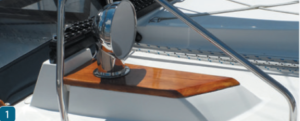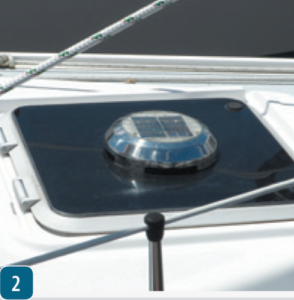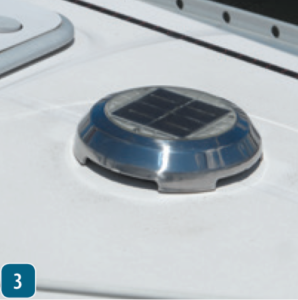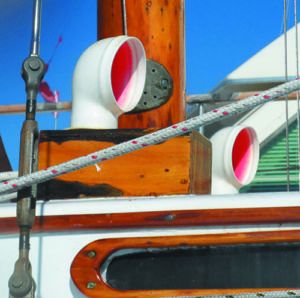There are really three reasons we ventilate; in summer to beat the heat, in the off-season to fight moisture build up from cooking and breathing, and when we are away from the boat to prevent mildew. Catalogs are full of cowls, breeze boosters, bug nets, and powered vents, all guaranteed to solve your problem. And we’ve reviewed them before. In August 2000, Practical Sailor looked at passive and powered vents, as well as a fabric breeze booster that doubled the flow through an open hatch.
But we didn’t quantify the air flow or investigate how location and wind angle affected the performance of passive vents, such as cowls and low profile vents. Sure, they probably perform as advertised on a flat, unobstructed deck, with the wind from straight ahead, but what about the real world of turbulent airflow and the wind blowing from other directions while at the dock? And how much does a bug screen or dorade box reduce the flow? You want to know these things before you start drilling big holes in the deck.
How We Tested
We started testing on various boats, but quickly realized we couldn’t control the wind speed, direction, or geometry. So we built a replica plywood cabin trunk to which we fitted hatches, cowls, dorade boxes, and low profile ventilators in a variety of locations. We created a wind tunnel by arranging a stack of five box fans 20 feet away to create a reasonably even wind field. Anemometer windspeed measurements around the replica cabin confirmed that airflow patterns matched those predicted by theory. Relative pressure was judged by measuring flow through a plain hole at these locations.
How We Tested
First we measured the flow through each vent type using an anemometer, with the wind from dead ahead. Vents were rotated through different positions on the cabin replica to determine the effect of changes in local pressure differential and turbulence. We then rotated the cabin relative to the airflow to simulate wind from a variety of angles, representative of sailing to windward or secured in a slip. We then added a dorade box under the cowl vent in several locations and wind directions, and added bug screens to see how much they reduced the flow.
Observations
Cooling and dehumidification are two different things. For cooling a sweaty crewmember, nothing beats air directed against the skin. Because it scrubs away the boundary layer of air and thus increases evaporation and heat transfer, it feels cooler than a vent pulling the same volume of air away as exhaust. Dehumidification to prevent mold, on the other hand, depends only on changing enough air to keep the interior in rough equilibrium with its surroundings.
Exhaust. Air must have somewhere to go. This may seem self-evident, but it bears reminding that it is equally as important to plan for exhaust as for intakes. When we are on board the companionway is generally open or at least cracked, providing exhaust or intake according to the wind direction, but when we button the boat up to go home, ventilation can suffer. Some companionways have louvers and some have openings or leaky weather stripping around the slider, but some do not.
Pressure balance. We were a little surprised by how strongly the exact position of a vent on the cabin top influenced flow. A passive vent installed in a negative pressure area will exhaust, but move it just a few feet to a positive pressure area it becomes an intake. Located in a turbulent area there may be no flow.
This can also change when the wind direction changes. A forward-facing cowl always produced at least a weak intake, but in a low pressure area, we would get even stronger exhaust flow if we took it off. This balance is far more important than the brand or any design detail. See “Pressure Differential and Impacts on Air Flow” sidebar.
Lack of wind. Wind really doesn’t blow much in the harbor. Even with a nice 10-15 knots sailing breeze on the bay, the wind in the slip, at deck- level (the masthead doesn’t count) was seldom more than 5 knots. Sure, there were also days when it touched 30 knots, but the mold will happily grow on windless days and wait through the breezy ones. You need ventilation that functions in light winds. Preventing mold typically requires at least one air change per hour, or 700-1800 cubic foot per hour (CFH) for boats from 25-40 feet.
Bilge air. Ventilate the bilge, and make darn sure it is always exhausted. It stands to reason, the worst air on the boat is in the bilge. It is damp and potentially diesel-laden. Strangely, few boats are set up to draw air directly from the bilge. There may be a few louvers, but not any real draft.
Cowls and dorade boxes. Cowl vents usually have a water trap, which is traditionally provided via a dorade box. Our test dorade box and internal baffle (12-inches long, 6-inches wide, 5-inches tall, with 3-inch baffle) restricted air flow about 30 percent. However, the overall effect is often increased flow, because the box elevates the cowl above deck turbulence. The cowl vents with built-in dorade boxes tend to be less efficient because the smaller box creates an additional 10 percent wind flow resistance and does not elevate the cowl as far. Every vent should be closable for severe weather. Rotating the cowl just 30-degrees away from the wind can decrease flow by 60-80 percent.
Screens. Cruising boats seek out places beyond the reach of flying bugs, so for maximum ventilation all screens should be removable. Standard window screen reduces flow about 30 percent, and no-see-um screen cuts flow by about 48 percent.
Day vs. Night. Best practices for ventilation varies with ambient temperature and humidity, which changes with each diurnal shift from day to night. When it comes to powered exhaust/intake vents, there is some debate over their best use during the day and night (see adjacent story, “Which Dries Faster”).
Weatherproofing. The intake must be protected from rain. If air is drawn in using a powered vent, the airflow can suck rain in through plain louvers. Larger louver openings help by reducing velocity. Dodgers really help with ventilation, not just underway and at anchor, but also at the dock by allowing increased companionway ventilation.
Ventilation, Day or Night
Vent manufacturer, Vetus has strong feelings about ventilators. It uses mushrooms in its low-profile ventilators, but maintains that domed ventilators should not be closable, in order to keep the inside and outside temperature and humidity the same and thus prevent condensation.
As the Vetus catalog states: “Ventilators powered by solar cells are, in our opinion, not useful since they start operating when it gets warmer during sunshine hours when the air can absorb more vapor. They should, in fact, operate at night when the air is cooler and condensation takes place, but they don’t do that.”
Another leading manufacturer of marine vents, Nicro, takes a different approach. Nicro makes seven different domed ventilators, six of which have fans powered by 12V, solar, or solar plus Ni-Cads, in two sizes (3- and 4-inches diameter) with plastic (white or black) or stainless steel covers.
So what do we do with powered vents? We’ve experimented with dehumidifiers and they are far more efficient when run at night than during the day because temperatures are lower at night, and the humidity is higher. The exception, of course, is in the winter when ice may build at night if temperatures fall below 50F.
So yes, ventilation purely for dehumidification is more important at night than during the day, and a solar-only system may not be optimum, particularly in humid, low wind locations.
The solution? Install either multiple cowl vents, which can move air even in lighter winds, or select a powered ventilator that also has nighttime capability.
We can use the suction on the lee side of a sail to pull the boat forward. In the same fashion, we can use pressure differentials surrounding the cabin to ventilate the cabin. Thus, understanding the flow over the cabin and the pressure differential it creates is vital to the success of any passive ventilation scheme. It also explains why some passive ventilation methods did so poorly in our testing.
The cabin top has a number of pressure zones, and these change, depending on the wind direction. At anchor, the front of the cabin is high pressure, the top slightly reduced, but this depends on the location; it is lowest just behind the front edge, slowly rising to neutral depending on the extent of turbulence. The companionway area has the lowest pressure; open a hole anywhere forward and air will be sucked out the companionway, through gaps in the weather stripping if it’s closed.
Air flow through vents can be interrupted not just by insufficient pressure differential, but also turbulence. Cabin edges, masts, changes in wind direction, and even other cowls can dramatically reduce the wind speed striking the cowl.
The most complicated case is at the dock, with everything buttoned up to go home. The wind can blow from any direction, and depending on the extent of protection afforded by the harbor and neighboring boats, it will be light most of the time. Passive vents are often rated at 10 knots, but the true wind, at deck level, in most marinas is less than 5 knots 90 percent of the time.
- Cowl vents on top of dorade vents reach up above disturbed air flow to capture air in what would otherwise be a ‘dead’ zone with very little flow. Notice the need for powered vents astern to ensure any significant ventilation.
- In the same location disturbed by turbulence in a bow-on wind, a low-profile Nicro Mini-Vent 500 may produce very little ventilation flow. However, the same vent exposed to wind-flow across the bow will be effective.



Nicro 500 air Vent
This flying-saucer shaped vent is basically a low-profile dorade box that stop rain, and when sealed, keep out green water during heavy going. We had a pair of these on the bows of a performance cat for many years, and they didn’t break, snag, or leak. If placed in a turbulent or neutral pressure location, these may produce no exhaust flow at all. Compared to a plain hole in the cabin roof, we found the Nicro 500 reduces flow by about 50 percent.
Bottom line: These are not effective ventilators, but are suitable for intake or exhaust when paired with powered fans or cowl ventilators.
Nicro Standard Cowl Vent
A traditional cowl design, this vent must be paired with a dorade box or replaced with blank plugs when it is not in use. Unless protected by a cage, the tall shape is perfect for snagging lines and even getting pulled off and tossed into the ocean. And they take up locker space when not mounted. That said, the design has been around for so long because it works.
Bottom line: Recommended if paired with a dorade box.
Cabin Ventillation
| MANUFACTURER | PRODUCT | VENT SIZE | LOCATION | DIRECT FLOW CFH* (%CHANGE IN FLOW RATE) | PRICE |
|---|---|---|---|---|---|
| ACCESS HATCH | Davis | 4" x 4" sq. | Cabin forward bulkhead | 1,751 CFH | 16 |
| CABINTOP HATCH | Bomar (hatch open 60 degrees) | 16"x16" sq. | Cabintop hatch | 14,500 CFH | 430 |
| DAVIS INSTRUMENT | Wind Scoop (hatch fully open) | 16"x16" sq. | Over cabin top hatch | 28,000 CFH | 65 |
| NICRO | Low profile cowl | 3' dia. | Top of cabin, forward | 1,592 CFH | 59 |
| NICRO | Low profile cowl | 3' dia. | Top of cabin, aft | 1,326 CFH | 59 |
| NICRO | Low profile cowl | 3' dia. | Top of cabin, forward with DIY dorade box | 1,990 CFH | 59 |
| NICRO | Low profile cowl | 3' dia. | Top of cabin, forward with DIY dorade box | 2,938 CFH | 89 |
| NICRO | Standard cowl | 3' dia. | Top of cabin, forward | -448 CFH | 115 |
| DIY DORADE (NO COWL) | Air Vent 500 | No cowl | Top of cabin, forward | - 584 CFH | ~$15 |
| DIY DORADE (W/MATCHING COWL) | Dorade box 12"x 6"x5" (LWH) with 3' baffle | To fit | Flow increase applies to all locations | (+25 percent) | ~$15 |
| INTEGRATED FIBERGLASS DORADE | Dorade box 12"x 6"x5' (LWH) with 3' baffle | To fit | Flow increase applies to all locations | (-31 percent) | ~$100 |
| GENERIC SCREEN | #16 mesh window screen | To fit | Flow increase applies to all locations | (-30 percent) | NA |
| PHIFFER | Phifertex | To fit | Flow increase applies to all locations | (-62 percent) | NA |
| PHIFFER | No-see-um Screen | To fit | Flow increase applies to all locations | (-44 percent) | NA |
| POWERED VENTS | |||||
| MARINCO | Day-Night Solar Vent | 3" dia. | All | -500 CFH | 220 |
| NICRO | Solar Mini-Vent 1000 | 3" dia. | All | -700 CFH | 110 |
Nicro Low Profile Cowl
Experience tells us that low profile cowls are just as likely to snag a line as traditional cowl vents. Even though the opening and flow area is approximately the same as the traditional design, capacity is considerably less because it sits closer to the deck in disturbed air, and because the flow path is less efficient. They look modern, but they just are not as effective.
Bottom line: Traditional cowl vents are a better choice.
Davis Breeze Booster
The standard answer for cooling at anchor is a big open hatch. The downside is that you will be up closing hatches every time it rains and you won’t be able to use it underway in a breeze because of spray and even green water. Genoa sheets can catch, often damaging the hatch. Each sleeping compartment should have a hatch large enough to serve for egress in an emergency (and just hope you didn’t strap the dinghy on top of it).
In the past, we’ve evaluated several products like the ATN Doorcap, designed to enhance flow and keep water out (see PS May 2015, “Gear Fit for Summer Sailing”). However, we’ve found the best performers—especially in light winds—to be the taller, lighter wind-scoops like the Davis Breeze Booster.
The Breeze Booster’s lightweight fabric helps push a lot of air through the boat. In light winds, it typically doubles the airflow. Downsides include funneling twice as much rain below, long set-up time, vulnerability in squalls, and instability in cross winds at dock. (The Dorcap solves many of those issues.)
Bottom line: Our Best Choice for use at anchor in light wind areas.
Nicro 1000
A basic powered vent, the Nicro 1000 moves a steady 700 CFH out of the cabin during the day. Lacking a battery, it stops when the sun goes down, which is arguably the wrong time to stop (there is more water in the air during the day than at night). On the other hand, we’ve had them for years and they work, independent of wind direction. An air inlet must be provided. Includes standard insect screen. Built-in baffles block rain and can be closed to block green water.
Bottom line: Recommended for basic at-dock ventilation.
Sometimes a simple twist of a cowl or a change in the type of vent you use in certain locations will noticeably improve air flow below decks.
- Protective line-guards can quickly earn their keep. We’ve lost to cowls overboard, and sheets that snag during tacks are dangerous.
- By placing the ventilator in the hatch, one less hole is needed and the deck remains clear. Unfortunately, it blocks light and introduces potential leaks.
- Marinco Day/Night Plus vent moves air 24 hours per day, keeping the interior air temperature and humidity in equilibrium with the outside.
- Dorade boxes need not be fancy. It’s just a box with a baffle and perimeter water drains.
- Our test shows that airflow through cowls drops by 65 to 80 percent if they don’t face the wind. On unattended boats that are stored in marinas with variable winds, you can point the cowls in four different directions to maximize flow.






Marinco Day/Night Plus Vent
This vent includes a battery to provide 24-hour operation, which means it moves twice as much air for the same rating and pulls in drier nighttime air as well. Includes an insect screen. Built-in baffles block rain and can be closed to block green water.
Bottom line: Solar vents backed by batteries for night are the Best Choice for ventilating unattended boats.
Conclusions
Cowls mounted on dorade boxes and a cracked companionway offer smart ventilation for a boat underway. In fair weather, hatches are the big movers.
Location is everything. Intakes should be in clear air and elevating them on dorade boxes helps. Exhausts should be in low-pressure areas. Because the wind direction varies both underway and at dock, passive intakes and exhausts can both fail or reverse rather unpredictably. At the dock, powered ventilators are the only reliable air movers for mildew prevention.
Snagging can be a nightmare. Protective cages are a smart plan.
If you don’t like active systems, then four cowl vents will give dependable flow. At the dock, you can vary their opening direction by 90 degrees to capture wind from all directions.
And don’t forget bilges and the far ends of the boat. A bilge deserves its own vent and the far ends are a crap shoot for passive ventilators.










































Thanks I found a upright ac/dehumidifier to work well. With windows covering.
Btw I’m looking for a real good dinghy for my 33 Egg Harbor. With 12ft stern and swim platform. Two dogs must visit shore.
I like to row. But might carry a Torquedo electric.
Cruise Lake Superior mostly.
I think Vetus is incorrect on on daytime ventilation and I don’t think it’s valid to compare dehumidifier operations to ventilation. As the author mentions, dehumidifiers work best at night when the cooler air is more saturated. But ventilation is different because it is not working on the air sealed in the cabin, it is exchanging outside and inside air, ideally drawing in drier air and exhausting more humid air. So, if it matters, I think daytime would be the best time to ventilate, because you’ll be drawing in dry air. Ventilate at night and you are drawing in moist air. Now if you have a source of humidity in your boat (people, water leaks, etc), which will continually keep the indoor humidity levels higher than the outdoors, it’s probably useful to ventilate at any/all time(s) of the day.
That’s my theory anyway, maybe this is a future test.
The day night question is counter intuitive as we are talking relative humidity vs total humidity. I am not an expert, but the theory is, that although relative humidity is lower during the day, the actual water content is lower at night even though it feels more humid. So if you fill the boat with night air, then raise the temperature during the day while not ventilating, then the boat will actually be dryer all day.
In practice I like a day night battery solar vent. I am considering installing a battery with its own solar source and vetus vent12 continuous fans, as my luck with Nicro has been poor in recent years.
Thanks Drew, very interesting.
A couple of thoughts regarding dorade boxes: a ball can be added to the baffle, working on the same principle as the pingpong ball in early snorkels, the ball floats and blocks the air and water flow when the cowl takes a wave. We found that very successful. Also be aware when using multiple cowls that they must not be interconnected lest the high pressure at one vents straight out of another.
Long ago I came to the conclusion that the larger the dorade box volume the better the airflow. Sometimes deck lockers, anchor compartments and the like, which self drain, can be utilised to perform the services of a purpose build dorade box.
At the dock when the boat is closed up, I have AC electric fans running continuously to move air. I have Nicro solar vents in cabin hatches where one sucks air in and the other exhausts. I can run DC fans when away from the dock if needed. I have a CSY 44 center cockpit with numerous deck hatches. I had dorades in my Jeanneau that were worthless
I agree with Vetus that vents should be closable from the inside. If in heavy seas or if it is raining, not so convenient to replace vent with a plate. If not on boat, you will come back with water all over the place. Nice for your varnished bulkheads. Often I just use duct tape on my Nicro solar vent to keep water out.
For my two Dorade boxes, I have installed inexpensive computer fans – exhaust in head and into the boat for the other box. Draws very little power and I tend to keep running a lot of the time.